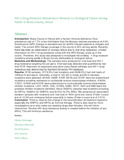| dc.description.abstract | Introduction: Busia County of Kenya with a Human Immune-deficiency Virus prevalence rate of 7.7% is two-fold higher than the Kenyan national prevalence at 4.9%. Antiretroviral (ARV) therapy is standard care for all HIV infected patients to mitigate viral loads. The current ARV therapy coverage in the county is 95% among adults. Recently there has been an observation of virologic failure due to viral drug resistance. Limited information on HIV-1 drug-resistance exists with the ARV therapy scale-up in the county. Therefore, this study was designed to investigate the existing -1 drug-resistant mutations among adults in Busia County attributable to virological failure.
Materials and Methodology: The samples were analyzed for viral load and HIV-1 drug-resistance targeting the pol gene. Viral load was detected and quantified by real time PCR. Alignment of sequences was done using Recall software and HIV-1 drug-resistance was determined by Stanford University HIV database.
Results: Of 50 samples, 37(74.0%) had mutations and 34(68.0%) had viral loads of 1000cp/ml and above. Generally, a total of 142 (82 in males and 60 in females) mutations were detected. M184V, K65R, K70R, D67N and T215F were the predominant mutations encoding resistance to nucleoside reverse transcriptase inhibitors. K103N, Y181C, G190A and K101E were predominant to nonnucleotide reverse transcriptase inhibitor mutations. L231, V82A, 150L, E138G, G48V, I501T, I54V and M461were the protease inhibitor mutations identified. About 30(60%) samples had mutations encoding for NRTIs, 34(68%) for NNRTIs, and 6(12%) for PIs ARVs. We observed an association between samples with mutations and viral load of 1000 cp/ml and above (Fisher’s exact test of <0.05) and virological failure especially in males (Fisher’s exact test of 0.013).
Conclusion: There is need for the change in the recombination of treatment regimens especially the NNRTIs and NRTIs as first line therapy. There is also need for more investigations as to why males are resisting drugs than females, this will inform intervention. Routine HIV drug-resistance testing is needed before the initiation of any ARVs. This will minimize resistance. | en_US |

